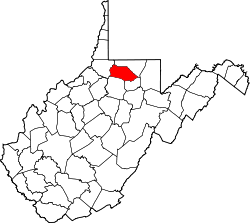Grant Town, West Virginia | |
|---|---|
 Location of Grant Town in Marion County, West Virginia. | |
| Coordinates: 39°33′26″N80°10′43″W / 39.55722°N 80.17861°W | |
| Country | United States |
| State | West Virginia |
| County | Marion |
| Area | |
• Total | 0.54 sq mi (1.40 km2) |
| • Land | 0.53 sq mi (1.37 km2) |
| • Water | 0.015 sq mi (0.04 km2) |
| Elevation | 988 ft (301 m) |
| Population | |
• Total | 690 |
| 685 | |
| • Density | 1,127.0/sq mi (435.14/km2) |
| Time zone | UTC-5 (Eastern (EST)) |
| • Summer (DST) | UTC-4 (EDT) |
| ZIP code | 26574 |
| Area code | 304 |
| FIPS code | 54-32908 [3] |
| GNIS feature ID | 1554592 [4] |
| Website | https://granttown.myruralwater.com/ |

Grant Town is a town in Marion County, West Virginia, in the eastern United States. The population was 690 at the 2020 census. [2]
Contents
- Notable people
- Geography
- Demographics
- 2010 census
- 2000 census
- Folklore
- The Vegetable Man
- Notes
- External links
The town was formed in 1901 with the opening of the Federal Coal and Coke Company bituminous coal mine, and was named for Robert Grant, vice president of the coal company. The "Federal No. 1" mine remained open for the next 84 years until its closure in 1985.[ citation needed ] At one point it was the largest underground coal mine in the world in terms of gross production, mining the Pittsburgh coal seam. The town was incorporated as a municipality in 1946.
Grant Town is the site of an 80 Megawatt electrical generation facility, located adjacent to the coal refuse areas above the town. The plant, which was built in the early 1990s is controlled by Edison International and generates electricity using a fluidized bed combustion boiler process burning waste coal. [5]
Grant Town is the location of a number of the stories of the West Virginia ghost story anthology The Telltale Lilac Bush, by Fairmont State University professor Ruth Ann Musick. [6] The town, the mine and surrounding farms are prominently featured in a number of the stories. Musick includes a description of the town, circa 1965, in an introduction to a section on mine ghost stories:
"The Grant Town Mine, the scene of four of the stories here, is one of the largest in the United States, and possibly in the world. The town itself, with a population of a little over a thousand, is about seven miles northwest of Fairmont. Surrounded by hills, it is a kind of a sunken garden--a well at the bottom of the stairway of hills and highways--so that it seems to be in a world of its own. In a way, perhaps, it is. At least fourteen different European nationalities live in the town and work in the mine." [7]
